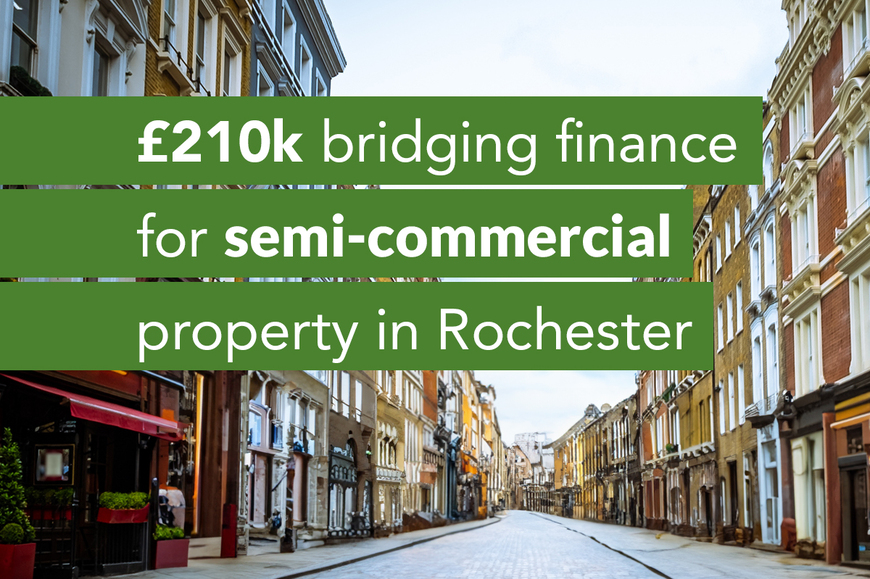On this page
Financing a semi-commercial property purchase in Rochester for business owner A semi-commercial opportunity close to home The Buy-To-Let aspect of the opportunity The challenge Developing the property with renovations Financing the purchase through a bridge loan A swift exit strategy through refinancing onto a BTLFinancing a semi-commercial property purchase in Rochester for business owner
A small business owner in Rochester leverages a bridge loan to quickly purchase a £385,000 semi-commercial property where his business had been located for almost 10 years as the landlord sought to sell.

A semi-commercial opportunity close to home
Having operated a business from the premises for nearly a decade, the business owner had built up a great local trade for their microbrewery.
When the landlord advised the tenant they intended to sell the 4-storey property, the tenant saw an opportunity to safeguard and grow their business, but also to add an additional revenue stream to the business through entering the buy-to-let sector and renting the 3 upper floors, which were already set up as a 5 bedroom self-contained flat.
There was an added benefit for the microbrewery too; the ground floor could potentially be extended into the large rear yard to add much-needed additional square footage for the business.
The Buy-To-Let aspect of the opportunity
The flat, once refurbished, would likely provide an additional revenue stream for the business and command a rental amount over around £2,500 pcm - the average around Rochester.
Due to its central location, a quick 39-minute commute into London St Pancras for London professionals, and Rochester's large student population of around 4,500 undergraduates, the buyer was confident in the rental potential.
With the existing £2,000 pcm in rent the business was already paying, the total net rent was £4,500 pcm. The cost of a BTL mortgage interest-only option came in at just over £1,600 for the principal loan of £280,000; the numbers seemed to stack up.
Unfortunately, the flat in its current condition would pose a problem for a BTL mortgage lender. As such, short-term finance was sought to bridge the gap between the initial purchase plus renovations to the flat and then refinancing onto a BTL mortgage.
The challenge
As the landlord was looking for a quick sale, the semi-commercial property was priced keenly; however, for the tenant to secure the property, they would need to complete the purchase within 8 weeks.
Raising finance in this timeframe wasn't possible via a high-street bank due to the flat being in an uninhabitable state. Additionally, the grade II listed status of the property meant that the extension on the yard wouldn't be particularly straightforward as planning hadn't yet been sought.
Whilst extending a grade II listed building is possible, the planning application would need to meet all the local policies for extension as well as the listed building requirements.
The buyer decided to focus on completing the purchase, renovating the residential aspect and refinancing onto a BTL mortgage as the priority, ensuring the bridging loan exit was as quick as possible. A planning application could then be submitted for the extension, and the rent could be used to cash flow both the BTL mortgage and the planning application.
Developing the property with renovations
Structurally, the property was in fair condition, apart from a small water ingress issue due to some roof damage. The residential aspects needed some damp remediation for the same reason: a new kitchen, two new bathrooms, and general modernisation before being let out.
The owner had budgeted £22,000 for the remedial work and the internal refurbishment, with a £6,000 contingency. As it was grade II listed, no internal structural improvements were planned to ensure speed of refurbishment.
Financing the purchase through a bridge loan
To cover the renovation costs as well as a large portion of the initial purchase of the property, the business owner was seeking a bridge loan totalling £210,000. For the property being purchased at £385,000, this loan had a 54% Loan-to-Value (LTV). The buyer anticipated a £60,000 increase in the value of the property post-refurb, which whilst not offering a vast profit, meant a loss was considered very unlikely.
A swift exit strategy through refinancing onto a BTL
The bridge was in place for 9 months to ensure the exit strategy would be met and no further rebridging would be required. In reality, the property was refinanced well within the bridging loan terms. Once refurbished, the property was valued at £435,000 - slightly less than hoped for but still offered a comfortable 48% LTV, meaning a BTL mortgage was quickly sourced.
Once the work on the property was completed, the business owner refinanced the property onto a BTL mortgage. Due to the area's high demand, they quickly found tenants shortly after putting the property onto the rental market. The success of the business owners' property transaction, in no small part due to the ease of access to bridging finance, has given them an appetite to tackle the potentially arduous planning application process for extending their grade II listed investment.
